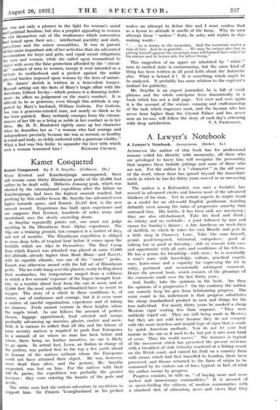Kamet Conquered
Kamet Conquered. By F. S. Smythe. (Gollancz. 16s.) WITH Everest and Kanchenjunga unconquered, there still remain some thirty Himalayan peaks of the 25,000 foot calibre to be dealt with. Hitherto Jonsong peak, which was climbed by the international expedition after the failure on Kanchenjunga, had been the highest summit reached, but profiting by this earlier lesson Mr. Smythe has advanced even higher towards space, and Kamet, 25,447 feet, is the new summit record. Experience has built upon experience and one supposes that Everest, hundreds of miles away and unsubdued, sees the slowly encircling doom.
As Smythe repeatedly points out, one must not judge anything in the Himalayas from Alpine experience. The Alps are a training ground, but conquest is a matter of days and not of months. The Himalayan expedition is obliged to cross deep belts of tropical heat before it comes upon the foothills which are Alps in themselves. The Base Camp from which Kamet was attacked was placed at some 15,000 feet altitude, already higher than Mont Blanc—and Kamet, with its equable climate, was one of the " easier " peaks. Kamet was otherwise armed with the full set of Himalayan perils. The ice walls hung over the glaciers, ready to fling down their avalanches, the temperature ranged from a coldness in which a few seconds' exposure of the fingers brought frost- bite, to a terrible direct heat from the sun at noon, and at 25,000 feet the most carefully acclimatized have to resort to oxygen. The story of a climb in these conditions is, of course, one of endurance and courage, but it is even more a matter of careful organization, experience and of taking no chances. Fools cannot venture in these heights where the angels tread. As one follows the account of porters chosen, luggage apportioned, food selected and camps gradually advancing up moraine, glacier, couloir and snow- field, it is curious to reflect that all this and the labour of some seventy natives is required to push four Europeans to a summit of ice where no man has been before and where, there being no further incentive, no one is likely to go again. In actual fact, Lewa, an Indian in charge of the porters, was pushed first to the top a few yards ahead in honour of the natives without whom the Europeans could not have attained their object. He was, however, more dead than alive, and the gesture, Mr. Smythe suspected, was lost on him. For the natives with their 100 lb. packs, the expedition was probably the greater heroism : they were entering the haunts of the gods and devils.
The white man had his curious adventure in mysticism to support him. Sir Francis Younghusband in his preface makes an attempt to define this and I must confess that as a hymn to altitude it smells of the lamp. Why do men attempt these " useless " feats, he asks, and replies in shy. making words : " . . . he is drawn to the mountain. And the mountain makes a man of him. And he is grateful ... We may be certain also that in pitting himself against the mountain man will himself have added to his stature and be better able for loftier living."
This suggestion of an upper air inhabited by " white " men in rarified state is embarrassing, but the same kind of thing has been written in all good faith about the Antarctic also. What is behind it ? It is something which ought to be analysed. It probably has some relation to the explorer's instinct for publicity.
Mr. Smythe is an expert journalist, he is full of vivid phrases and the whole enterprise lives dramatically in a book which has not a dull page. Yet over and over again it is the account of the science, cunning and craftsmanship of the task which engrosses most, and the layman who has never been higher than the Crystal Palace and has never seen an ice-axe, will follow the story of each day's scheming






























 Previous page
Previous page